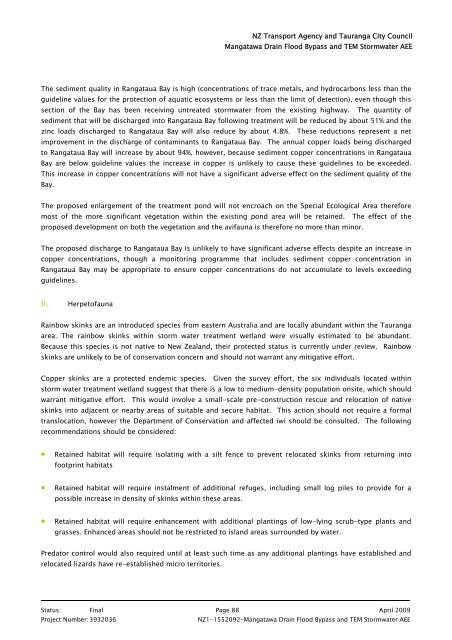2. Mangatawa catchment consents for earthworks, storm water ...
2. Mangatawa catchment consents for earthworks, storm water ...
2. Mangatawa catchment consents for earthworks, storm water ...
- No tags were found...
You also want an ePaper? Increase the reach of your titles
YUMPU automatically turns print PDFs into web optimized ePapers that Google loves.
NZ Transport Agency and Tauranga City Council<br />
<strong>Mangatawa</strong> Drain Flood Bypass and TEM Storm<strong>water</strong> AEE<br />
The sediment quality in Rangataua Bay is high (concentrations of trace metals, and hydrocarbons less than the<br />
guideline values <strong>for</strong> the protection of aquatic ecosystems or less than the limit of detection), even though this<br />
section of the Bay has been receiving untreated <strong>storm</strong><strong>water</strong> from the existing highway. The quantity of<br />
sediment that will be discharged into Rangataua Bay following treatment will be reduced by about 51% and the<br />
zinc loads discharged to Rangataua Bay will also reduce by about 4.8%. These reductions represent a net<br />
improvement in the discharge of contaminants to Rangataua Bay. The annual copper loads being discharged<br />
to Rangataua Bay will increase by about 94%, however, because sediment copper concentrations in Rangataua<br />
Bay are below guideline values the increase in copper is unlikely to cause these guidelines to be exceeded.<br />
This increase in copper concentrations will not have a significant adverse effect on the sediment quality of the<br />
Bay.<br />
The proposed enlargement of the treatment pond will not encroach on the Special Ecological Area there<strong>for</strong>e<br />
most of the more significant vegetation within the existing pond area will be retained. The effect of the<br />
proposed development on both the vegetation and the avifauna is there<strong>for</strong>e no more than minor.<br />
The proposed discharge to Rangataua Bay is unlikely to have significant adverse effects despite an increase in<br />
copper concentrations, though a monitoring programme that includes sediment copper concentration in<br />
Rangataua Bay may be appropriate to ensure copper concentrations do not accumulate to levels exceeding<br />
guidelines.<br />
ii.<br />
Herpetofauna<br />
Rainbow skinks are an introduced species from eastern Australia and are locally abundant within the Tauranga<br />
area. The rainbow skinks within <strong>storm</strong> <strong>water</strong> treatment wetland were visually estimated to be abundant.<br />
Because this species is not native to New Zealand, their protected status is currently under review. Rainbow<br />
skinks are unlikely to be of conservation concern and should not warrant any mitigative ef<strong>for</strong>t.<br />
Copper skinks are a protected endemic species. Given the survey ef<strong>for</strong>t, the six individuals located within<br />
<strong>storm</strong> <strong>water</strong> treatment wetland suggest that there is a low to medium-density population onsite, which should<br />
warrant mitigative ef<strong>for</strong>t. This would involve a small-scale pre-construction rescue and relocation of native<br />
skinks into adjacent or nearby areas of suitable and secure habitat. This action should not require a <strong>for</strong>mal<br />
translocation, however the Department of Conservation and affected iwi should be consulted. The following<br />
recommendations should be considered:<br />
• Retained habitat will require isolating with a silt fence to prevent relocated skinks from returning into<br />
footprint habitats<br />
• Retained habitat will require instalment of additional refuges, including small log piles to provide <strong>for</strong> a<br />
possible increase in density of skinks within these areas.<br />
• Retained habitat will require enhancement with additional plantings of low-lying scrub-type plants and<br />
grasses. Enhanced areas should not be restricted to island areas surrounded by <strong>water</strong>.<br />
Predator control would also required until at least such time as any additional plantings have established and<br />
relocated lizards have re-established micro territories.<br />
Status: Final Page 88 April 2009<br />
Project Number: 3932036<br />
NZ1-1552092-<strong>Mangatawa</strong> Drain Flood Bypass and TEM Storm<strong>water</strong> AEE
















